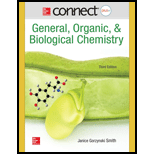
Concept explainers
(a)
Interpretation:
Concept Introduction:
CFC compounds are short form of chlorofluorocarbon in which compound consist of chlorine, fluorine and carbon.
HCFC compounds are short form of hydrochlorofluorocarbon in which compound consist of hydrogen, chlorine, fluorine and carbon.
HFC compounds are short form of hydrofluorocarbon in which compound consist of hydrogen, fluorine and carbon.
(b)
Interpretation:
Concept Introduction:
CFC compounds are short form of chlorofluorocarbon in which compound consist of chlorine, fluorine and carbon.
HCFC compounds are short form of hydrochlorofluorocarbon in which compound consist of hydrogen, chlorine, fluorine and carbon.
HFC compounds are short form of hydrofluorocarbon in which compound consist of hydrogen, fluorine and carbon.
(c)
Interpretation:
Concept Introduction:
CFC compounds are short form of chlorofluorocarbon in which compound consist of chlorine, fluorine and carbon.
HCFC compounds are short form of hydrochlorofluorocarbon in which compound consist of hydrogen, chlorine, fluorine and carbon.
HFC compounds are short form of hydrofluorocarbon in which compound consist of hydrogen, fluorine and carbon.
Want to see the full answer?
Check out a sample textbook solution
Chapter 14 Solutions
Connect 2-Year Access Card for General, Organic and Biological Chemistry
- Write the complete balanced equation for the combustion of octane (C8H18), which is one of the most important components in gasoline.arrow_forwardPropane (C3Hg) is a common fuel used for cooking on outdoor grills.arrow_forwardPeroxyacetył nitrate (PAN) is one of the prime irritants in photochemical smog. It has the formula CH;COOONO, with the following structure: H;C-C 0-0-NO,arrow_forward
- Ethanol can be used as a fuel source in an alcohol lamp. The formula for ethanol is C2H5OH. Write the balanced equation for the combustion of ethanol.arrow_forwardWrite a balanced chemical equation for the hypothetical reaction of liquid dichloromethane, CH2CI2, with solid NaAaBb3 to form solid CH2(AaBb3)2 and another product.arrow_forwardcigarette lighters burn butane, C4H10. write a balanced equation, assuming complete combustion, that is, plenty of oxygen.arrow_forward
- What is the balanced molecular equation for the complete combustion (in the presence of excess oxygen) of: C6H6 (benzene, an important industrial chemical and solvent)?arrow_forwardThe reaction of pentane, C5H12, with oxygen, O2, gives carbon dioxide and water. (a) Write a balanced equation for this reaction.arrow_forwardWhat mass of methane is required to produce 1.130 kg of carbon dioxide during combustion? (Assume the reaction undergoes complete combustion.) CH4(g) + O2(g) → CO2(g) + H2O(g) O 411.8 g O 113.2 g O 24.5 garrow_forward
- (a) Write separate balanced equations for the complete combustion of ethanol (C2H5OH)and of gasoline (represented by the formula C8H18).arrow_forward7. A natural gas sample was analyzed to contain 84% (by volume) CH4, 10% C2H6, 3% C3H8, and 3% N₂. If a series of catalytic reactions could be used for converting all the carbon atoms into butadiene, C4H6, with 100% efficiency, how much butadiene could be prepared from 100 g of the natural gas? Note: Volume percent of a gas mixture is nn mala normant the O 1530 g 82 g O 28 g 3150 garrow_forward4. Write and balance the combustion reaction of 1-naphtol, C1oHsOarrow_forward
 Chemistry for Engineering StudentsChemistryISBN:9781337398909Author:Lawrence S. Brown, Tom HolmePublisher:Cengage Learning
Chemistry for Engineering StudentsChemistryISBN:9781337398909Author:Lawrence S. Brown, Tom HolmePublisher:Cengage Learning
